Ausgewählte Erzählungen aus Somadeva's
Ozean der Erzählungsströme
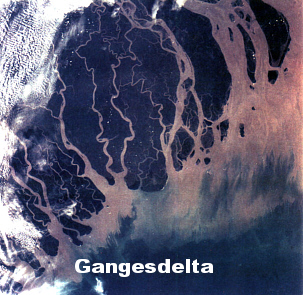
5. Buch I, Welle 4
3. Vers 87 - 137: Fortsetzung der Geschichte Vararucis
verfasst von Somadeva
übersetzt und erläutert von Alois Payer
mailto:payer@payer.de
Zitierweise / cite as:
Somadeva <11. Jhdt. n. Chr.>: Kathāsaritsāgara : der Ozean der
Erzählungsströme : ausgewählte Erzählungen / übersetzt und erläutert von
Alois Payer. -- 5. Buch I, Welle 4. -- 3. Vers 87 - 137: Fortsetzung der
Geschichte Vararucis. -- Fassung vom 2006-12-08. --
http://www.payer.de/somadeva/soma053.htm
Erstmals publiziert: 2006-12-08
Überarbeitungen:
Anlass: Lehrveranstaltung WS 2006/07
©opyright: Dieser Text steht der Allgemeinheit zur Verfügung. Eine
Verwertung in Publikationen, die über übliche Zitate hinausgeht, bedarf der
ausdrücklichen Genehmigung des Verfassers
Dieser Text ist Teil der Abteilung
Sanskrit von
Tüpfli's Global Village Library
Falls Sie die diakritischen Zeichen nicht
dargestellt bekommen, installieren Sie eine Schrift mit Diakritika wie z.B.
Tahoma.
Der Sanskrit-Text folgt im Wesentlichen folgender Ausgabe:
Somadevabhaṭṭa <11. Jhdt.>: Kathāsaritsāra / ed. by Durgāprasād and
Kāśīnāth Pāṇḍurāṅg Parab. -- 4. ed. / revised by Wāsudev Laxman Śāstrī Paṇśikar.
-- Bombay : Nirnaya-Sagar Press, 1930, -- 597 S. -- [in Devanāgarī]
Die Verse sind, wenn nichts anderes vermerkt ist, im Versmaß Śloka abgefasst.
Definition des Śloka in einem Śloka:
śloke ṣaṣṭhaṃ guru jñeyaṃ
sarvatra laghu pañcamam
dvicatuṣpādayor hrasvaṃ
saptamaṃ dīrgham anyayoḥ
"Im Śloka ist die sechste Silbe eines
Pāda schwer, die fünfte in allen Pādas leicht
Die siebte Silbe ist im zweiten und vierten Pāda kurz, lang in den beiden
anderen."
Das metrische Schema ist also:
̽ ̽ ̽ ̽ ˘ˉˉ ̽
̽ ̽ ̽ ̽ ˘ˉ˘ ̽
̽ ̽ ̽ ̽ ˘ˉˉ ̽
̽ ̽ ̽ ̽ ˘ˉ˘ ̽
Zur Metrik siehe:
Payer, Alois <1944 - >: Einführung in die Exegese von
Sanskrittexten : Skript. -- Kap. 8: Die eigentliche Exegese, Teil II:
Zu einzelnen Fragestellungen synchronen Verstehens. -- Anhang B: Zur Metrik
von Sanskrittexten. -- URL:
http://www.payer.de/exegese/exeg08b.htm
Mahākaviśrīsomadevabhaṭṭaviracitaḥ
Kathāsaritsāgaraḥ
Der von großen Dichter, dem Ehrwürdigen Gelehrten Somadeva verfasste Ozean
der Erzählungsströme
Kommentar:
Zu Autor und Werk siehe:
Somadeva <11. Jhdt. n. Chr.>: Kathāsaritsāgara
: der Ozean der Erzählungsströme : ausgewählte Erzählungen / übersetzt
und erläutert von Alois Payer. -- 1. Einleitung. --
http://www.payer.de/somadeva/soma01.htm
caturthas taraṅgaḥ
atrāntare tuṣārādrau
kṛtvā tīvrataraṃ tapaḥ |
ārādhito mayā devo
varadaḥ pārvatīpatiḥ |87|
87. Inzwischen hatte ich im Frostgebirge1
sehr harte Askese geübt und den wunscherfüllenden Gott, den Gatten Pārvatīs2,
zufriedengestellt.
Kommentar:
1 Frostgebirge: Himalaya
2 wunscherfüllenden Gott, den Gatten
Pārvatīs: Śiva
tad eva tena śāstraṃ me
pāṇinīyaṃ prakāśitam |
tadicchānugrahād eva
mayā pūrṇīkṛtaṃ ca tat |88|
87. Deswegen hat er mir das Pāṇinische Lehrwerk1
geoffenbart. Dank seines gnädigen Wunsches habe ich es vervollständigt2.
Kommentar:
1 Pāṇinische Lehrwerk:
die Aṣṭādhyāyī, siehe oben, zu Vers 20
2 vervollständigt: durch die Vārttikā's, siehe
oben, zu Vers 20
tato 'haṃ gṛham āgaccham
ajñātādhvapariśramaḥ |
niśākarakalāmauli-
prasādāmṛtanirbharaḥ |89|
89. Dann kehrte ich nachhause zurück ohne Ermüdung
durch den Weg zu spüren; war ich doch voll von der Unsterblichkeitsspeise der
Gnade dessen, der in seiner Haarflechte den Sechzehntelmond trägt1.
Kommentar:
1 der in seiner Haarflechte den
Sechzehntelmond trägt: Śiva
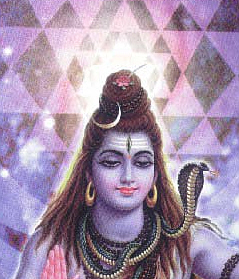
Abb.: "der in seiner Haarflechte den Sechzehntelmond trägt"
[Bildquelle. Wikipedia]
atha mātur gurūṇāṃ ca
kṛtapādābhivandanaḥ |
tatropakośāvṛttāntaṃ
tam aśrauṣam mahādbhutam |90|
90. Ich verehrte die Füße meiner Mutter und meiner
Meister; dann erfuhr ich das sehr wunderliche Erlebnis1 Upakośās.
Kommentar:
1 das sehr wunderliche Erlebnis
Upakośās: siehe oben Vers 28 bis 86
tena me paramāṃ bhūmim
ātmany ānandavismayau |
tasyāṃ ca sahajasneha-
bahumānāv agacchatām |91|
90. Dadurch erreichten meine Freude und mein
Erstaunen, meine echte Liebe zu ihr und meine Hochachtung vor ihr den höchsten
Rang in mir.
varṣo 'tha manmukhād aicchac
chrotuṃ vyākaraṇam navam |
tataḥ prakāśitaṃ svāmi-
kumāreṇaiva tasya tat |92|
92. Varṣa wünschte, aus meinem Munde die neue
Grammatik zu hören. Da hat sie ihm Svāmikumāra1 persönlich
geoffenbart.
Kommentar:
1 Svāmikumāra = Svāmī = Kumāra = Skanda/Kārtikeya/Murugan;
siehe I,2, zu Vers 44
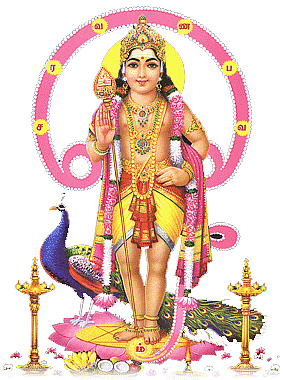
Abb.: Svāmikumāra
[Bildquelle: Wikipedia]
tato vyāḍindradattābhyāṃ
vijñapto dakṣiṇāṃ prati |
gurur varṣo 'bravīt svarṇa-
koṭir me dīyatām iti |93|
93. Dann erkundigten sich Vyāḍi und Indradatta nach
dem Brahmanengeschenk1. Meister Varṣa forderte 10 Millionen
Goldstücke.
Kommentar:
1 Brahmanengeschenk: dakṣiṇā = das,
was man einem Brahmanen als Gegengabe für seine Dienstleistungen gibt.
| "Another striking feature of the ancient
educational system was the total absence of any prior agreement
about fess for teaching students. So earli as Bṛ Up. IV. 1,2 we find
Yājñavalkya saying to king Janaka who offered to give him a thousand
cows, an elephant and a bull (or as Śaṃkara explains an elephantlike
bull , ' my father was of opinion that without fully teaching a
pupil one should not receive any reward from him '.
Gaut. (II. 54-55 ) says that at the end of
his studies the student should request the teacher to accept the
wealth that he could offer or ask the teacher what should be given
and after paying or doing what the teacher wants or if the teacher
allowed him to go without demanding anything, the student should
take the ceremonial bath (i. e. return home ).
The Āśv. gṛ. (III. 9. 4) has almost the same
words.
The Āp. Dh. S. (I. 2. 7. 19-23) requires the
student to offer at the end of his studies, whatever their extent
may be, a dakṣiṇā obtained from proper sources to his teacher
according to his abilities and that if the teacher is in
straightened circumstances, to offer him a fee even by begging from
a person who is of the Ugra caste or from a Śūdra and that after
offering a fee or doing even a very strikingly good turn to his
teacher he should not boast of it to others nor should he ever dwell
in his mind over it.
The ideal was that the dakṣiṇā ( fee) offered
to the teacher at the end of study was simply for pleasing or
propitiating the teacher and was not a complete equivalent of or
compensation for the knowledge imparted.
Manu (II. 245-246) says that the student need
not give anything to the teacher till his snāna; when he is about to
return home, he may offer to his guru some wealth; that the gift of
a field, gold, a cow, or a horse, of even shoes or an umbrella, of a
seat, corn, vegetables and clothes ( either singly or together) may
engender pleasure in the teacher.
The Chān. Up.879 III. 11.6 eulogises
brahmavidyā by declaring it to be more valuable than the gift of the
whole earth together with all its wealth.
The smrtis declare that even if the guru
teaches a single letter to the pupil, there is nothing in this world
by giving which the pupil can get rid of the debt he owes.
The Mahābhārata says ( Āśvamedhika 56. 21 )
that the teacher's satisfaction with the student's work and conduct
is indeed the proper dakṣiṇā.
Yāj. I. 51 says that one should give to his
teacher what he chooses to ask as dakṣiṇā and Kātyāyana quoted by
Aparārka (p. 76) prescribes that a brāhmaṇa pupil may give a cow, a
princely one a village, a vaiśya a horse (if able to do so ).
It has been shown above ( p. 355) how kings
and others made gifts of lands or provided for salaries to teachers.
One of the earliest record about university scholarships is
contained in the Bahur (near Pondichery) plates of Nṛpatuṅgavarman
in which we find a grant to a Vidyāsthāna (a seat of learning) for
promotion of learning ( E. I. vol. 18 p. 5 ).
In E. I. vol. 15 p. 83 there is provision of
30 mattars of land for professors lecturing to ascetics and of eight
mattars to teachers giving lessons to the youths in a monastery (in
the times of Cālukya Someśvara I at Sūdi in Dharwar District in śake
981).
The Peshwa distributed to learned brāhmaṇas
every year dakṣiṇā which rose to 4 lakhs of rupees a short time
before 1818 A. D.
It may be stated that even in the 20th
century there are numerous brāhmaṇa teachers of the veda and the
śāstras who teach pupils for years without stipulating for any fee
or even receiving any thing from them.
According to Manu II. 141, Śaṅkhasmṛti III. 2 and Viṣṇu Dh. S. 29. 2
a teacher who teaches the Veda or the Vedaṅgas for money or for his
livelihood is called an Upādhyāya.
Yāj. III. 235 and Viṣṇu Dh. S. 37. 20 and
others include teaching for money (and also learning from a paid
teacher) among upapātakas (lesser sins).
Manu III. 156, Anuśāsana 23. 17 and Yāj. I.
223 say that he who is a hired teacher (bhṛtakādhypaka) and he who
learns from such a teacher are not fit to be invited at a śrāddha.
But Medhātithi (on Manu II. 112 and III. 146
), the Mit. ( on Yāj. III. 235 ), the Sm. C. and others say that a
person does not become a hired teacher by accepting something from a
pupil, but that what is condemned is making a stipulation beforehand
that one would teach only if a certain sum or if so much were paid
or delivered.
In distress, Mann X. 116 and Yāj. III. 42
allow even such stipulations for the purpose of securing one's
livelihood.
The Mahābhārata ( Ādi. 133.2-3) shows that when Bhīṣma appointed
Droṇa as the teacher of the Pāṇḍava and Kaurava princes he bestowed
on him wealth and a well-furnished house full of corn; but there was
no stipulation.
It has been shown above (p. 113 ) that it was the king's duty to
support learned men and students and to see that no brāhmaṇa died of
hunger in his kingdom ( vide Gaut X. 9-12, Viṣṇu Dh. S. III. 79-80,
Manu VII. 82-85, Yāj. I. 315, 333). So a student, when the teacher
demanded a heavy fee at the end of studies, could theoretically at
least approach a king for the fee.
Kālidāsa draws in Raghuvaṃśa V a graphic
picture how Varatantu demanded a dakṣiṇā of 14 crores from his pupil
Kautsa who approached Raghu for the same and would not take more
than his requirements.
Sometimes the teacher or his wife, according
to legends, demanded fanciful dakṣiṇās. For example, Uttaṅka was
asked by his teacher's wife, when he urged her to take something, to
bring the ear-rings of the queen of the reigning king ( vide
Ādiparva chap. 3 and Āśvamedhika-parva 56 )."
[Quelle: Kane, Pandurang Vaman <1880 -
1972>: History of Dharmasastra : (ancient and mediaeval,
religious and civil law). -- Poona : Bhandarkar Oriental Research
Institute. -- Vol. II, part 1. -- 2. ed. -- 1974. -- S. 359 - 362] |
aṅgīkṛtya guror vākyaṃ
tau ca mām ity avocatām |
ehi rājñaḥ sakhe nandād
yācituṃ gurudakṣiṇām |94|
gacchāmo nānyato 'smābhir
iyat kāñcanam āpyate |
navādhikāyā navateḥ
koṭīnām adhipo hi saḥ |95|
94. - 95. Sie akzeptierten die Forderung des Meisters
und sprachen zu mir: "Freund des Königs!, komm!, wir gehen, um von König Nanda1
das Brahmanengeschenk für unseren Meister zu erbitten. Von keinem anderen werden
wir so viel Gold bekommen. Ist er doch Herr über 990 Millionen Goldstücke.
Kommentar:
1 Nanda = vermutlich ist Mahāpadma Nanda (450
B.C - 362 B.C) gemeint, der Begründer der Nanda-Dynastie, siehe
I,2, zu Vers 2
vācā tenopakośā ca
prāg dharmabhaginī kṛtā |
ataḥ śyālaḥ sa te kiṃcit
tvadguṇaiḥ samavāpyate |96|
96. Durch sein Wort hat er Upakośā vorher zur
rechtlichen Schwester1 gemacht; deshalb ist er dein Schwager. Dank
deiner Eigenschaften werden wir etwas erreichen."
Kommentar:
1 Schwester: siehe oben,
Vers 85
iti niścitya nandasya
bhūpateḥ kaṭakaṃ vayam |
ayodhyāstham agacchāma
trayaḥ sabrahmacāriṇaḥ |97|
97. So beschlossen wir drei und gingen mit unseren
Schülern zur Residenz König Nandas in Ayodhyā1.
Kommentar:
1 Ayodhyā
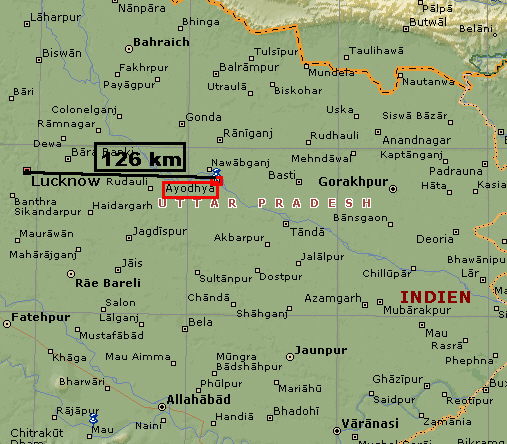
Abb.: Lage von Ayodhyā
(©MS Encarta)
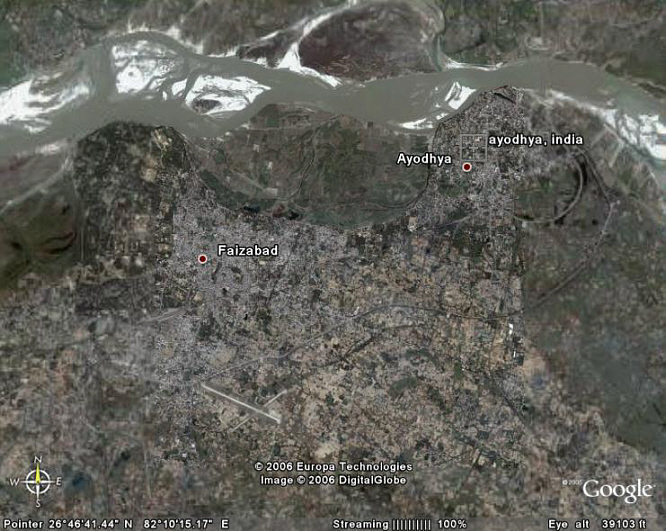
Abb.: Satellitenaufnahme von Ayodhyā
(©Google Earth)
| "Ayodhya (Hindi: अयोध्या, Urdu:
ایودھیا IAST Ayodhyā) is an ancient city of India, the old
capital of Awadh, in the Faizabad district of Uttar
Pradesh. Under the British
Raj the city and the administrative area around it was called Oudh. It is on the
right bank of the river Sarayu, 555 km east of New Delhi. The word
ayodhya is Sanskrit for "not to be warred against". Some Puranas
like the
Brahmanda Purana (4/40/91) consider Ayodhya as one of the six holiest cities.
In the first few centuries of the Common Era it
was caled Śāketa. Śāketa, or 沙奇 (Pinyin: Shāqí) was conquered by the
great Kushan / Yuezhi [月氏] Emperor Kanishka (Kushan language: ΚΑΝΗϷΚΙ,
Ancient Chinese: 迦腻色伽) c. 137 CE, who made it the administrative
centre of his eastern territories. The name occurs again in Faxian [法顯]
as 沙祗 (Pinyin: Shāzhī) in the early fifth century. It is not clear
when the name changed, but by the time of the visit of the Chinese
pilgrim monk, Xuanzang [玄奘], c. 636
CE, it was known as Ayodhya.
Legacy and Importance
Ayodhya was one of the most ancient, largest and
most magnificent of Indian cities. It is said to have covered an
area of 250 km² (96 square miles), and was the capital of the Hindu
kingdom of Kosala (Kaushal), the court of the great king Dasaratha,
the 56th monarch of the Solar line in descent from
Raja Manu. The opening chapters of the Ramayana, a religious epic of the
Classical Hindu period, recount the magnificence of the city, the
glories of the monarch and the virtues, wealth and loyalty of his
people. Dasaratha was the father of Rama
Chandra, the Seventh Avatar of the Vishnu. Many Hindus believe the birthplace of
Rama to be in Ayodhya at the place called
Ram Janmabhoomi (राम जन्मभूमि) , the site of the demolished Babri
Mosque (Urdu:
بابری مسجد,
Hindi: बाबरी मस्जिद). According to the
Ramayana, Ayodhya was ruled by the House of Ikshvaku, who was the
son of Manu.
Ayodhya is also the birth place of five
Tirthankars, including the first Tirthankar of Jainism, Shri Rishabh
Dev. He is known as the father of Jain religion. The city is also
important in the history and heritage of Buddhism in India, with
several Buddhist temples, monuments and centers of learning having
been established here during the age of the
Mauryan Empire and the Gupta
Dynasty. Ayodhya reached its glorious peak as known to history during the reign
of the Guptas over India.
Bhagwan
Swaminarayan, founder of the Swaminarayan Sect of Hinduism lived here during his
childhood years. It was from Ayodhya that Bhagwan Swaminarayan
started his seven year journey across India as Neelkanth.
Tulsidas [तुलसीदास] is said to have begun the
writing of his famous Ramayana poem (Shri Rama Charit Manas) in
Ayodhya in 1574. Several Tamil Alwar mention the city of Ayodhya.
Ayodhya is also said to be the birthplace of
Bhahubali, Brahmi, Sundari, King Dasaratha, Acharya
Padaliptasurisvarji, King
Harishchandra, Shri Rama,
Achalbhrata, and the ninth Gandhara of Mahavir Swami.
The Atharva
Veda called Ayodhya "a city built by gods and being as prosperous as paradise
itself".
Ayodhya was the victim of pillage and sacking
during the Ghaznavid raids and Ghorid invasions. Some Hindu temples
were allegedly looted or destroyed. Some believe that the Babri
Mosque was constructed on the remains of a temple, but this claim
remains very controversial. With Muslim rulers established around
the city under Mohammed of Ghor, it lost its strategic and economic
importance to Lucknow (Hindi: लखनऊ; Urdu: لكهنو;Lakhnau)
and Kanpur (Hindi: कानपुर, Urdu: کانپُر).
Ayodhya today is a small, rustic city with
ancient Hindu architecture predominating, and with some Mughal
influence. Its population is mostly Hindu with a minority of
Muslims, Jains and Buddhists. However, its history and heritage hold
an unequivocal importance for over Hindus in India and across the
world.
The Thai kingdom and city of
Ayutthaya [อยุธยา] were named for Ayodhya, reflecting the common Southeast Asian
practice of adopting place names from Hindu mythology.
GeographyAyodhya
is located at 26.8° N 82.2° E.
It has an average elevation of 93 metres (305 feet).
DemographicsAs of 2001
India census, Ayodhya had a population of 49,593. Males constitute
59% of the population and females 41%. Ayodhya has an average
literacy rate of 65%, higher than the national average of 59.5%;
with 66% of the males and 34% of females literate. 12% of the
population is under 6 years of age.
Ayodhya Debate
Ayodhya is also the centre of the Ayodhya Debate concerning the
Ram Janmabhoomi temple and the Babri
Mosque. The mosque was destroyed in 1992 by Kar Sevaks and rioters due to the
belief that the Ram Janmabhoomi existed prior to the mosque's
construction and that the temple was the birthplace of Rama.
Mob AttackOn 5 July 2005,
five militants attacked the site of the makeshift Ramlalla temple, in Ayodhya.
All five were shot down in the ensuing gunfight with the security
forces guarding the area, and one civilian died in the bomb blast
triggered by the terrorists to breach the cordon wall."
[Quelle:
http://en.wikipedia.org/wiki/Ayodhya. -- Zugriff am 2006-11-27]
|
| "Archaeology of Ayodhya
Archaeological studies in the 1970s: Project "Archaeology
of the Ramayana Sites"
Though results were not reported in that
period, between 1975 and 1985 an archaeological project was carried
out in Ayodhya to examine some sites that were connected to the
Ramayana story. The Babri Mosque site was one of the fourteen sites
examined during this project. After a gap of many years since the
ecavations the BB Lal led ASI team claimed in the Rashtriya
Swayam-sevak Sangh (RSS) magazine Manthan in October 1990 of having
found the pillar-bases of what may have been a temple at the site
which must have belonged to a larger building than the Babri Mosque.
The team of archaeologists of the ASI, led by
B.B. Lal, found rows of pillar-bases which must have belonged to a
larger building than the Babri Mosque.
Accordingly, archaeological findings of
burnt-brick pillar bases a few metres from the mosque indicated that
a large temple stood in alignment with the Babri Mosque since the
11th century. (B.B. Lal (Manthan,10/1990) and S.P. Gupta (Indian
Express, 2 December 1990), and annexure 28 to the VHP document
Evidence for the Ram Janmabhoomi Mandir. ) In a trench at a distance
of four metres south of the mosque parallel rows of
pillar-foundations, made of brick-bats and stones, were found.
[1]
Professor Gupta later commented on the
findings of the period prior to 1990: „ Several of the temple
pillars existing in the mosque and pillar- bases unearthed in the
excavations conducted in the south of the mosque (although in the
adjoining plot of land) show the same directional alignment. This
will convince any student of architecture that two sets of material
remains belong to one and the same complex.“
[2]
June to July 1992
In July 1992, eight eminent archaeologists (among them former ASI
directors Dr. Y.D. Sharma and Dr. K.M. Srivastava) went to the
Ramkot hill to evaluate and examine the findings. These findings
included religious sculptures and a statue of Vishnu. They said that
the inner boundary of the disputed structure rests, at least on one
side, on an earlier existing structure, which “may have belonged to
an earlier temple”. (Indian Express, 4 July 1992.) The objects
examined by them also included terracotta Hindu images of the Kushan
period (100-300 AD) and carved buff sandstone objects that showed
images of Vaishnav deities and of Shiva-Parvati. They concluded that
these fragments belong to a temple of the Nagara style (900-1200
AD).
Prof. S.P. Gupta commented on the discoveries:
"The team found that the objects were datable to the period
ranging from the 10th through the 12th century AD, i.e., the period
of the late Pratiharas and early
Gahadvals. (....) These objects included a number of
amakalas, i.e., the cogged-wheel type architectural element which crown the
bhumi shikharas or spires of subsidiary shrines, as well as the top
of the spire or the main shikhara ... This is a characteristic
feature of all north Indian temples of the early medieval period
(...) There was other evidence - of cornices, pillar capitals,
mouldings, door jambs with floral patterns and others - leaving
little doubt regarding the existence of a 10th - 12th century temple
complex at the site of Ayodhya."
[3]
2003: The ASI report
The
Archaeological Survey of India (ASI) excavated the mosque site at the direction
of the
Allahabad Bench of the Uttar
Pradesh
High Court in 2003. The archaeologists reported evidence of a large 10th century
structure similar to a Hindu temple having pre-existed the Babri Masjid. A team
of 131 labourers including 29 Muslims - who were later on included on the
objections of the Muslim side - was engaged in the excavations. In June 11, 2003
the ASI issued an interim report that only listed the findings of the period
between May 22 and
June 6, 2003.
In August 2003 the ASI handed a 574-page report to the Lucknow Bench of the
Allahabad High Court.
The ASI, who examined the site, issued a
report of the findings of the period between May 22 and June 6, 2003.
This report stated:
- Among the structures listed in the
report are several brick walls ‘in east-west orientation’,
several ‘in north-south orientation’, ‘decorated coloured floor’,
several ‘pillar bases’, and a ‘1.64-metre high decorated black
stone pillar (broken) with yaksha figurines on four corners’ as
well as "Arabic inscription of holy verses on stone"
[4] Earlier reports by
the ASI, based on earlier findings, also mention among other
things a staircase and two black basalt columns ‘bearing fine
decorative carvings with two crosslegged figures in bas-relief
on a bloomed lotus with a peacock whose feathers are raised
upwards’.
The ASI report of August 25, 2003 stated that
there was evidence of a large Hindu temple having pre-existed the
Babri mosque. The ASI report mentions a huge structure (11-12th
century) on which a massive edifice, having a large pillared hall (or
two halls), with at least three structural phases and three
successive floors attached with it was constructed later on. The
report also stated that "there is sufficient proof of existence of a
massive and monumental structure having a minimum of 50 x 30 metre
in north-south and east-west directions respectively just below the
disputed structure". The ASI report of 2003 concluded that: "Viewing
in totality and taking into account the archaeological evidence of a
massive structure just below the disputed structure and evidence of
continuity in structural phases from the tenth century onwards up to
the construction of the disputed structure along with yield of stone
and decorated bricks as well mutilated sculpture of divine couple....,
fifty pillar bases in association of the huge structure, are
indicative of remains which are distinctive features found
associated with the temples of north India."
Some results of the 2003 ASI report:
Period 1000BC to 300BC:
The findings suggest that a
Northern Black Polished Ware (NBPW) culture existed at the mosque site between
1000 BC and 300 BC. A round signet with a legend in Asokan Brahmi , terracotta
figurines of female deities with archaic features, beads of
terracotta and glass, wheels and fragments of votive tanks have been
found. [5]
Sunga Period. 200 BC:
Typical terracotta mother goddess, human and
animal figurines, beads, hairpin, pottery (includes black slipped,
red and grey wares), and stone and brick structures of the Sunga
period have been found. [6]
Kushan period. 100-300 AD:
Terracotta human and animal figurines,
fragments of votive tanks, beads, bangle fragments, ceramics with
red ware and large-sized structures running into twenty-two courses
have been found from this level. [7]
Gupta era (400-600 AD) and post-Gupta era:
Typical terracotta figurines, a copper coin
with the legend Sri Chandra (Gupta), and illustrative potsherds of
the Gupta period have been found. A circular brick shrine with an
entrance from the east and a provision for a water-chute on the
northern wall have also been found.
[8]
11th to 12th century:
A huge structure of almost fifty metres in
north-south orientation have been found on this level. Only four of
the fifty pillar bases belong to this level. Above this lied a
structure with at least three structural phases which had a huge
pillared hall.
[9]
Radar searchIn the
January 2003, Candadian geophysiscist Claude Robillard performed a
search with a ground-penetrating radar. The survey concluded that "there
is some structure under the mosque". The structures were "ranging
from 0.5 to 5.5 meters in depth that could be associated with
ancient and contemporaneous structures such as pillars, foundation
walls, slab flooring, extending over a large portion of the site".
Claude Robillard, the chief
geophysicist stated that "there are some anomalies found underneath the site
relating to some archaeological features. You might associate them (the
anomalies) with pillars, or floors, or concrete floors, wall
foundation or something. These anomalies could be associated with
archaeological features but until we dig, I can't say for sure what
the construction is under the mosque."
[10]
InscriptionsHari-Vishnu inscription:
During the demolition of the Babri mosque in
December 1992, three inscriptions on stone were found. The most
important one is the Hari-Vishnu inscription inscribed on a 1.10 x
.56 metre slab with 20 lines that was provisionally dated to ca.
1140. The inscription mentioned that the temple was dedicated to "Vishnu,
slayer of Bali and of the ten-headed one" [Rama is an incarnation of
Vishnu who is said to have defeated Bali and Ravana].
[11] The inscription is
written in the Nagari Lipi script, a Sanskrit script of the 11th and
12th century.[12] It was
examined by world class Epigraphists and Sanskrit scholars (among
them Prof. A.M. Shastri).[13]
Ajay Mitra Shastri, Chairman of the
Epigraphical Society of India and a specialist in Epigraphy and
Numismatics, examined the Hari-Vishnu inscription and stated:
- "The inscription is composed in
high-flown Sanskrit verse, except for a small portion in prose,
and is engraved in the chaste and classical Nagari- script of
the eleventh-twelfth century AD. It was evidently put up on the
wall of the temple, the construction of which is recorded in the
text inscribed on it. Line 15 of this inscription, for example,
clearly tells us that a beautiful temple of Vishnu-Hari, built
with heaps of stone (sila-samhati-grahais) and beautified with a
golden spire (hiranya-kalasa-srisundaram) unparalleled by any
other temple built by earlier kings (purvvair-apy-akrtam krtam
nrpatibhir) was constructed. This wonderful temple (aty-adbhutam)
was built in the temple- city (vibudh-alaayni) of Ayodhya
situated in the
Saketamandala (district, line 17) (...). Line 19 describes god Vishnu as
destroying king Bali (apparently in the Vamana manifestation)
and the ten-headed personage (Dasanana, i.e., Ravana)."
[14]
PillarsPillar
bases were first discovered by the ASI's former director-general BB
Lall in 1975.
In the Babri Mosque were at least fourteen
stone pillars that have been dated to the early 11th century and
more pillars were found during excavations buried in the ground near
the mosque.
Two similar pillars were also found placed
upside down by the side of the grave of Fazle Abbas alias Musa
Ashikhan. This Muslim saint was the person that incited Mir Baqi to
destroy the Janmasthan temple and build a mosque on it.
[15]
Controversy of the archaeological findings
To meet Wikipedia's
quality standards, this article or section may require
cleanup.
Many Muslim and Marxist historians dispute
the finding of ASI report, such as Dr Sushil Shrivastava in his
review of ASI report. [16]
In fact, two Muslim graves were also
recovered in the excavation and as reported in Outlook weekly, the
items discovered in the 40 days of digging by the ASI team clearly
pointed to a Muslim habitation as early as 13th to 14th century.
While the ASI videographed and photographed the graves on April 22,
it avoided further analysis of the important evidence. The skeletons
found at the site were not sent for carbon-dating, neither were the
graves measured.Countercurrents / Outlook. Anirudha Srivastava a
former ASI archaeologist said that in some trenches, some graves,
terracotta and lime mortar and surkhi were also discovered which
indicated Muslim habitation and it was also surmised that there
existed some mosque on the site and that Babri was built on the site
of another mosque. [17]
Again Hindu parties claim that Richard M
Eaton, an American historian of medieval India, in his controversial
Essays on Islam and Indian History (ISBN 0-19-566265-2) documents
desecration of all Hindu temples between 1192 and 1760. The total
adds up to 80. Eaton in his book does not claim that this list is
exhaustive. Furthermore, each of theses 80 cases represents the
destruction of not just one, but of a large number of temples. For
example one of these 80 cases, the “1094: Benares,
Ghurid army” case, refers to the Ghurid royal army that “destroyed nearly one
thousand temples, and raised mosques on their foundations”. This
figure of 80 cases doesn't include a Ram temple at Ayodhya.
They also refer to a study by the
Archaeological Survey of India in 2003, conducted on the orders of the Indian
Supreme Court, the evidence indicates that a Hindu temple did exist
at the site prior to the construction of the mosque.
Hindu parties state that this study was
ignored or disputed by some Muslims and Marxists. Press reports
tended to underplay its importance, and often even stated that the
ASI report (of the findings of the period May 22 to June 6, 2003)
didn't find anything. Sandipan Deb commented on the ASI report:
“While most papers covering the new ASI report last week said that
it claims there was no structure under the Babri Masjid, what the
report actually says is that of the 30 recent trenches, the team has
found man-made structures in eight, and none in 16. In five, they
couldn’t decide due to ‘structural activities in the upper levels’ (mainly
the plinth of the Babri Masjid). One trench they did not survey.
Among the structures listed in the report are several brick walls
‘in eastwest orientation’, several ‘in northsouth orientation’,
‘decorated coloured floor’, several ‘pillar bases’, and a
‘1.64-metre high decorated black stone pillar (broken) with yaksha
figurines on four corners’. [18]
On the question whether Babri Masjid stands
at the site of the alleged Ram Janam Bhoomi temple, the historian
and son of former president Sarvepalli Radhakrishnan, Prof. S. Gopal,
in a lecture delivered in Madras in May 2004 claimed, "So far no
evidence has been found to support the claim the Babri Masjid was
constructed on the land that had been earlier occupied by a temple."
He asserted, "In Ayodhya to-day there are still about 30 places
where Rama was claimed to have been born." Some critics of the ASI
report further point out that the impartiality of the Director
General of the ASI was in question since he had been appointed by a
government whose leaders, they claim, were responsible or at least
colluded, and certainly failed, to stop the destruction of the
mosque.[19] Some also
claimed that India's leading archaeologists were kept away from the
dig, however the excavations were carried out or examined by leading
archaeologists, among them Prof. Gupta and many other archaeologists
examined the findings.
There are Marxist historians who say the
entire town of Ayodhya was settled by Buddhists, not Hindus, and the
town had a large number of Buddha viharas (Buddhist shrines).
Remains of some Buddhist shrines may be found in excavations, but
they are unrelated to Hindu claims.
In 2003 it was alleged by the Marxist paper
People's Democracy that the Hari-Vishnu inscription would correspond
to an inscription dedicated to Vishnu that was supposedly missing in
the Lucknow State Museum since the 1980s. The museum director
Jitendra Kumar however stated that the inscription had never been
missing from the museum, although it wasn't on display and he showed
the inscription of his museum at a press conference for all to see.
It was different in shape, colour and text contents from the
Vishnu-Hari inscription. (Hindustan Times, 8 May 2003). In addition,
there are photographs that show the Kar Sevaks carrying a huge
stone-slab bearing a sculpted frieze (e.g. In India Today, 31.
December 1992: p.33). And the inscription has been examined by many
leading
epigraphists like Prof. Ajay Mitra Shastri.
There were also attempts by Babri Masjid
supporters to prohibit all archaeological excavations at the
disputed site. Naved Yar Khan's petition at the Supreme Court to
prohibit all archaeological excavations at the Mosque site was
rejected. (The Hindu, 10 June 2003).Similarly there were questions
raised to what level the archaelogical digging should continue -
should they stop till the point an evidence of Hindu temple was
found with both Buddhists and Jains asking for the digging to
continue much further to find if they could also lay claim to the
site.
BBC News 14 March 2003
Pillar bases were first discovered by the
ASI's former director-general BB Lall in 1975. His report gave an
enormous boost to the pro-Hindu faction. It was however criticised
by archaeologist D. Mandal. In the excavation of 2003, fifty of "pillar
bases" were once again unearthed. Although they appear to be aligned,
D. Mandal's conclusion by archaeological theory stated that:
- "pillar bases" belonged to different
periods, that is, all of them had never existed together at any
point of time; they were not really in alignment with one
another they were not even pillar bases, but junctions of
walls, bases of the load-bearing columns at the intersections of
walls. [20]
Criticism of the Study Reports
|
|
The
neutrality of this section is
disputed.
Please see the discussion on the
talk page. |
BB Lal's announcement that brick base found
in the vicinity of the masjid could be meant for sustaining pillars
and therefore suggest the existence of a temple-like structure south
of the Babri masjid has been taken by the BJP as the basic evidence
for the existence of a temple where the masjid stood.
A group of Marxist experts examined the site
notebook and register of antiquities connected with the Ayodhya
excavations, studied the drawings, plans, photographs, and excavated
material and found that the claim of Prof. Lal regarding the
existence of a mandir-like structure was unsubstantiated. They
alleged that the existence of a brick base for pillars does not
prove that it could be of a temple. They also alleged that the
eighteen objects which VHP claims to have found at the site during
its excavations, which were witnessed neither by the Archaeological
Survey of India experts nor by any other Marxist archaeologists or
historians, are not in situ objects and could have been brought from
elsewhere.
Even in his own report submitted to the
Archaeological Survey of India in 1976-77 and in 1979-80, Professor
Lal had stated "several later medieval brick-and-kankar lime floors
have been met with, but the entire late period was devoid of any
special interest." The later medieval period indicated 17th-l8th
centuries. If remains of a structure of 17th-l8th centuries, are
found outside the masjid area, how do they prove the presence of a
temple that was supposedly built in the 11th century and destroyed
in the early 16th century? the Marxists asked. They also alleged
that the excavations did not reveal any pillars, or roof material of
the supposed temple at the site where the brick pillar base stood.
Interestingly, pieces of glazed ware pottery
were unearthed from the trenches above the floors associated with
the brick-pillar base structure and immediately below the general
floor of the Babri Masjid. It was alleged that Islamic glazed-ware
pottery has never been used in Hindu temple The presence of the
glazed pottery shows that as in other parts of Ayodhya, this site
also was inhabited by Muslims around the thirteenth century, and the
pillar structure could have been anything but a temple, had already
fallen down and gone out of use before the Muslim habitation.
Excavations conducted by Prof. A.K. Narain in other parts of Ayodhya,
where he claimed to have unearthed glazed ware in the trenches,
tried to uphold this view. Finds of Islamic glazed ware unearthed by
both B.B. Lal and A.K. Narain make it possible that the Muslims
lived in Ayodhya from the 13th century onwards and may have built a
mosque at the site of an old ruin.
Now about the black basalt stone-pillars used
in the four arches of the Masjid. VHP argues that they formed part
of the temple which was destroyed. Similar pillars are also found in
the graveyard nearby. All these differ in their style and diameter
and their total lack of stratigraphic association rules out the
possibility of their being an integral part of any single structure.
Such pillars are also found in other parts of Ayodhya in completely
unrelated contexts. Besides, the pillar bases existing at a distance
of about 60 feet to the south of the Babri Masjid structure are in
alignment with the pillars used in the Babd Masjid. They could have
been part of a veranda or a dwelling place or an animal shed and are
of no importance as such structures could be found in the area even
now. Thus, archeological evidence so far suggests the existence of
Muslim habitation proximal to the Masjid from the 13th century
onwards
(excerpted from KP Prakasam Ayodhya:
Questions of History)
Alleged Flaws of the ASI Report
While in its interim report the ASI said it had
found no signs of the temple. [21]
The final ASI report of August 25, 2003 stated that there was
evidence of a large Hindu temple having pre-existed the Babri mosque.
Midway into the excavations the courts ordered the removal of the
head of the ASI excavations for not following the excavation norms.[22]
On the basis of these investigations Suraj
Bhan and former Chairman of the Indian Council of Historical
Research Irfan
Habib concluded that what the ASI found was as a previous layer of mosque.
RebuttalThis was
refuted by many scholars, including Professor R. Nath who
concludes in "The Baburi Masjid, p.78": “The foregoing study
of the architecture and site of the Baburi Masjid has shown,
unequivocally and without any doubt, that it stands on the site of a
Hindu temple which originally existed in the Ramkot on the bank of
the river Sarayu, and Hindu temple material has also been used in
its construction.”
Politicial Reaction
The leaders of Babri Masjid Action -
Reconstruction committee expressed reservations on the credibility
of the ASI in carrying out the assignment impartially owing to
political pressure. ASI comes under the Ministry of Human Resource
Development, which was headed by Murli Manohar Joshi, himself an
accused in the Babri Masjid demolition case.[23]
The Muslim side expressed doubts on the final ASI report saying that
the notes and other draft items were destroyed by the ASI with the
24 hours of the final report submission.[24]
The sounding tests by a Canadian agency mentioned that some
structure or anomalies could be established but that could not be a
temple on a conclusive note.
Prof Suraj Bhan, who has personally taken an
inventory of the site, said the ASI had clubbed pottery from the
11th to the 19th century together and not really distinguished them
into different periods. He, however, questioned the basis for the
ASI interpreting that a massive burnt brick structure was that of a
Ram temple. "The Babri Masjid had a planned structure and the ASI
findings conform to this plan. The Nagar style of star-shaped temple
construction prevalent between the 9th and 12th century is not at
all present at the structure," he said.
One of the central findings in the ASI report
was a very large temple, the foundations of which far exceed the
circumference of the Babri mosque. According to Irfan Habib the
pillar-bases were actually the floor of the Babri Masjid, but a
large part of the foundations was located outside the confines of
the mosque and hence cannot possibly be confused with the mosque
floor, except by a highly prejudiced mind.
Along the same lines as Habib, Muslim
Personal Law Board secretary Mohammed Abdul Rahim Quraishi “said a
team of well-known archaeologists including Prof. Suraj Bhan had
visited the site and inspected the excavated pits and was of [the]
opinion that there was evidence of an earlier mosque beneath the
structure of the Babri Masjid”. (“ASI ‘finds’ temple, Muslim front
says no”, Hinduonnet.com, 25 August. 2003)
The two agree on a pre-Babri Muslim presence,
but it should ne noted that how Quraishi’s “interpretation”
of the findings is already starkly at variance with Habib’s: the
latter saw no mosque underneath, while Quraishi’s employee Bhan did.
This indicates the non-seriousness of at least one of these
interpretations, possibly both. By contrast, the ASI team could
settle for a single interpretation, just one, which also converges
with S.P. Gupta’s, K.N. Dixit’s and R.K. Sharma’s reading.
Noted lawyer Rajeev Dhawan said the
Ramjanmabhoomi-Babri Masjid case has taken a wrong turn and the ASI
report had no historical or moral significance and the conclusions
were based on political considerations. However, anti-temple lawyer,
Mr. Dhawan said, "The legal case did not relate to the question of
whether a temple existed on the site or not".[25]
Court defers the use of ASI report
The Special full Bench of the
Allahabad High Court, hearing the Ayodhya title suits on February 3 ruled that
the report of the Archaeological Survey of India (ASI), which
carried out excavations to find out whether a temple had ever
existed at the place where once the Babri
Masjid stood, would be seen only in the light of further evidence in the case.
The three-member bench further remarked “no doubt, the objections
taken against the report have to be considered before the ASI report
is acted upon but that situation will arise only when the court
decides the matter finally.”
The court remarked that it would not be
advisable nor expedient to make any comments at this stage regarding
the correctness or accuracy of the report, or the tenability or
otherwise of the objections. Whether the report is biased or suffers
from discrepancies or infirmities, or is unacceptable, for various
reasons stated in objections have to be considered along with the
rest of the evidence that has been brought on record, the Bench
added and said that in its considered view this is not the proper
stage to pronounce on these points.
References
- ^ (Professor B.
B. Lal, in the Hindu: 1 July 1998.)
- ^ (Indian
Express, 6 December 1990)
- ^ (Narain, Harsh.
1993. The Ayodhya Temple Mosque Dispute)
- ^ Sandipan Deb
in Outlook India, 23 June 2003
- ^ (Pioneer, 9
September 2003. Ayodhya: lost and found By Sandhya Jain)
- ^ (Pioneer, 9
September 2003. Ayodhya: lost and found By Sandhya Jain)
- ^ (Pioneer, 9
September 2003. Ayodhya: lost and found By Sandhya Jain)
- ^ (Pioneer, 9
September 2003. Ayodhya: lost and found By Sandhya Jain)
- ^ (Pioneer, 9
September 2003. Ayodhya: lost and found By Sandhya Jain)
- ^
[1] Rediff Online News, March 19, 2003
- ^ (Puratattva,
No. 23 (1992-3), pp. 35 ff.)
- ^ (Puratattva,
No. 23 (1992-3), pp. 35 ff.)
- ^ (Puratattva,
No. 23 (1992-3), pp. 35 ff.)
- ^ (Puratattva,
No. 23 (1992-3), pp. 35 ff.)
- ^ (Hans Bakker:
Ayodhya)
- ^
[2]
- ^
Deccan Herald September
8, 2003
- ^ (Outlook
India, 23 June)
- ^
News item
- ^
The Outlook
- ^
'No sign' of Ayodhya temple
- ^
Rediff
- ^
The Hindu News
- ^
Milligazette
- ^
Historians find flaws in ASI report
Escaping the ASI’s final conclusions
Further reading
- Swapan Dasgupta et al.: The Ayodhya
Reference: Supreme Court Judgement and Commentaries. 1995. New
Delhi: Voice of India.
ISBN 81-85990-30-1
- Ayodhya and the Future of India. 1993.
Edited by Jitendra Bajaj. Madras: Centre for Policy Studies.
ISBN 81-86041-02-8 hb
ISBN 81-86041-03-6 pb
- Elst,
Koenraad. 1991.
Ayodhya and After: Issues Before Hindu Society. 1991. New Delhi: Voice of India.
[3]
- Elst, Koenraad, Ayodhya, The Finale -
Science versus Secularism the Excavations Debate (2003)
ISBN 81-85990-77-8
- Elst, Koenraad,
Ayodhya: The Case Against the Temple (2002)
ISBN 81-85990-75-1
- R. Nath. Babari Masjid of Ayodhya,
Jaipur 1991.
- Thakur Prasad Varma and Swarajya Prakash
Gupta: Ayodhya ka Itihas evam Puratattva— Rigveda kal se ab
tak (‘History and Archaeology of Ayodhya— From the Time of the
Rigveda to the Present’). Bharatiya Itihasa evam Samskrit
Parishad and DK Printworld. New Delhi.
- Ayodhya ka Itihas evam Puratattva—
Rigveda kal se ab tak (‘History and Archaeology of Ayodhya— From
the Time of the Rigveda to the Present’) by Thakur Prasad Varma
and Swarajya Prakash Gupta. Bharatiya Itihasa evam Samskrit
Parishad and DK Printworld. New Delhi. (An important work on the
archaeology of the temple.)
- History versus Casuistry: Evidence of
the Ramajanmabhoomi Mandir presented by the Vishwa Hindu
Parishad to the Government of India in December-January 1990-91.
New Delhi: Voice of India.
[Quelle:
http://en.wikipedia.org/wiki/Archaeology_of_Ayodhya. -- Zugrif
am 2006-11-27] |
prāptamātreṣu cāsmāsu
sa rājā pañcatāṃ gataḥ |
rāṣṭre kolāhalaṃ jātaṃ |
viṣādena sahaiva naḥ |98|
98. Kaum waren wir angekommen ist der König in die
fünf Elemente zerfallen1. Im Reich erhob sich Wehgeschrei.
Gleichzeitig waren wir zutiefst beunruhigt.
1 in die fünf Elemente (pañcatā)
zerfallen = gestorben
Die fünf Elemente (mahābhūta/dhātu) sind:
-
pṛthivī - Erde
-
ap - Wasser
-
tejas - Feuer
-
vāyu - Wind
-
ākāśa - Äther
avocad indradatto 'tha
tatkṣaṇaṃ yogasiddhimān |
gatāsor asya bhūpasya
śarīraṃ praviśāmy aham |99|
99. Sofort sprach Indradatta, der
Yoga-Vollkommenheiten1 besaß: "Ich werde in den Körper des leblosen
Königs fahren.
Kommentar:
1 Yoga-Vollkommenheiten: yoga-siddhi:
Siehe Pātañjala-Yogasūtra III; besonders III, 39:
bandhakāraṇaśaithilyāt pracārasamvedanāc ca
cittasya paraśarīrapraveśaḥ |39|
"Durch Lockerung der Bindungsursache und durch
Wahrnehmung des Weggehens des Bewusstseins geschieht Betreten eines
Fremden Körpers."
| "Siddhi is a Sanskrit term for
spiritual power (or psychic ability); it literally means "a
perfection." It is known in Hinduism and Tantric
Buddhism. These spiritual powers supposedly vary from relatively simple forms of
clairvoyance to being able to levitate, to be present at various places at once,
to become as small as an atom, to materialize objects, to have
access to memories from past lives, and more. The term became known
in the West through the work of H.P.
Blavatsky. There are many perspectives of attaining
Siddhis. One school of thought states that they are a normal set of
occurrences that should not be focused upon because they will pull
one from the path. Other perspectives hold that each siddhi should
be pursued because it will allow one to understand the power of the
Godhead. Siddhis can occur in two ways: naturally, or as a result of
extended practice of austerities. They are often mentioned in
conjunction with Riddhi (pl Riddhis), which means material or
worldly wealth, power, luxurious lifestyles, etc.
Nine main Siddhis
- Parkaya Pravesh:
Parkaya Pravesh means one’s soul entering into
the body of some other person. Through this
knowledge even a dead body can be brought to
life.
- Haadi Vidya: This
Vidya or knowledge has been mentioned in several ancient texts. On acquiring
this Vidya, a person feels neither hunger nor
thirst, and can remain without eating food or
drinking water for several days at a stretch.
- Kaadi Vidya: Just
as one does not feel hungry or thirsty in Haadi
Vidya, similarly in Kaadi Vidya a person is not
affected by change of seasons, i.e. by summer,
winter, rain, etc. After accomplishing this
Vidya, a person shall not feel cold even if he
sits in the snow-laden mountains, and shall not
feel hot even if he sits in the fire.
- Vayu Gaman Siddhi:
Through this Siddhi a person can become capable
of flying in the skies and traveling from one
place to another in just a few seconds.
- Madalasa Vidya:
On accomplishing this Vidya, a person becomes
capable of increasing or decreasing the size of
his body according to his wish. Lord
Hanuman had miniaturized his body through this Vidya while entering the city of Lanka.
- Kanakdhara Siddhi:
One can acquire immense and unlimited wealth
through this Siddhi.
- Prakya Sadhana:
Through this Sadhana a Yogi can direct his
disciple to take birth from the womb of a woman
who is childless or cannot bear children.
- Surya Vigyan:
This solar science is one of the most
significant sciences of ancient India. This
science has been known only to the Indian Yogis;
using it, one substance can be transformed into
another through the medium of sun rays.
- Mrit Sanjeevani Vidya:
This Vidya was created by
Adi Shankaracharya. Through it, even a dead person can be brought back to life.
Eight Primary Siddhis
[Merkvers:
aṇimā laghimā prāptiḥ
prākāmyaṃ mahimā tathā |
īśitvaṃ ca vaśitvaṃ ca
tathā kāmāvasāyitā ||
Mahabharata Version
There is the concept of the
Ashta Siddhi (eight siddhis) in Hinduism. These are:
- Aṇimā: reducing
one's body even to the size of an atom
- Mahimā: expanding
one's body to an infinitely large size
- Garimā: becoming
infinitely heavy
- Laghimā: becoming
almost weightless
- Prāptị: having
unrestricted access to all places
- Prākāmyam:
realizing whatever one desires
- Iśitā::
possessing absolute lordship;
- Vaśitvam: the
power to subjugate all.
In Hinduism, Hanuman
possesses the ability to bestow the eight siddhis
and the
nava nidhi (nine types of wealth).
Srimad Bhagavatam Version
In the
Srimad Bhagavatam Lord Krishna describes the Eight Siddhis as:
- Aṇimā: Becoming
smaller than the smallest (an atom);
- Mahimā: Becoming
larger than the largest;
- Laghimā: Becoming
lighter than the lightest;
- Prāptị: Acquiring
anything from anywhere;
- Prākāmyam:
Obtaining or performing whatever one desires;
- Iśitā:
Manipulating the subpotencies of maya;
- Vaśitā: The power
to bring others under control;
- Kāmāvasāyitā:
Obtaining any desired result, to the highest
possible limit.
Ten Secondary Siddhis
In the
Srimad Bhagavatam Lord
Krishna describes the Ten Secondary Siddhis as:
- anūrmi-mattvam:
Being undisturbed by hunger, thirst, and other
bodily disturbances
- dūra-śravaṇa:
Hearing things far away
- dūra-darśanam:
Seeing things far away
- manaḥ-javah:
Moving the body wherever the mind goes (teleportation)
- kāma-rūpam:
Assuming any form desired
- para-kāya praveśanam:
Entering the bodies of others
- sva-chanda mṛtyuh:
Dying when one desires
- devānām saha krīḍā
anudarśanam: Witnessing and participating in
the pastimes of the Apsaras
- yathā sańkalpa
saḿsiddhiḥ: Perfect accomplishment of one's
determination
- ājñā apratihatā gatiḥ:
Orders or Commands being unimpeded
Five Siddhis of Yoga and Meditation
In the
Srimad Bhagavatam the Five Siddhis of Yoga and Meditation are described as:
- tri-kāla-jñatvam:
Knowing the past, present and future;
- advandvam:
Tolerance of heat, cold and other dualities;
- para citta ādi
abhijñatā: Knowing the minds of others and
so on;
- agni arka ambu viṣa
ādīnām pratiṣṭambhaḥ: Checking the influence
of fire, sun, water, poison, and so on;
- aparājayah:
Remaining unconquered by others;
Obtaining Siddhis
Siddhi powers are said to be
obtainable by meditation, control of the senses,
devotion, herbs, mantras, pranayama, or good birth.
Lord
Krishna states that:
"For a sage who has
conquered his senses, breathing and mind, who is
self-controlled and always absorbed in
meditation on Me, what mystic perfection could
possibly be difficult to achieve?" (SB 11.15.32)
Seeking siddhi powers is
often discouraged and considered to be an impediment
to spiritual advancement."
[Quelle:
http://en.wikipedia.org/wiki/Siddhi. -- Zugriff am 2006-12-07
|
arthī vararucir me 'stu
dāsyāmy asmai ca kāñcanam |
vyāḍī rakṣatu me dehaṃ
tataḥ pratyāgamāvadhi |100|
100. Vararuci soll als Bittsteller zu mir kommen. Ich
werde ihm das Gold geben. Vyāḍi soll meinen Körper bewachen bis ich wieder in ihn
zurückkehre."
ity uktvā nandadehāntar
indradattaḥ samāviśat |
pratyujjīvati bhūpe ca
rāṣṭre tatrotsavo 'bhavat |101|
101. Nach diesen Worten fuhr Indradatta in den Körper
Nandas. Als der König wieder zum Leben kam, feierte man im ganzen Reich.
śūnye devagṛhe dehaṃ
indradattasya rakṣitum |
vyāḍau sthite gato 'bhūvam
ahaṃ rājakulaṃ tadā |102|
102. Während Vyāḍi im leeren Tempel beim Körper
Indradattas Wache stand, bin ich zum Königspalast gegangen.
praviśya svastikāraṃ ca
vidhāya gurudakṣiṇām |
yoganando mayā tatra
hemakoṭiṃ sa yācitaḥ |103|
103. Ich trat ein, grüßte und bat den Yoga-Nanda um 10
Millionen Goldstücke als Brahmanengeschenk für den Meister.
tataḥ sa śakaṭālākhyaṃ
satyanandasya mantriṇam |
suvarṇakoṭim etasmai
dāpayeti samādiśat |104|
104. Da wies dieser Śakaṭāla, einen Minister des
echten Nanda an: "Gib ihm 10 Millionen Goldstücke!"
mṛtasya jīvitaṃ dṛṣṭvā
sadyaś ca prāptim arthinaḥ |
sa tattvaṃ jñātavān mantrī
kim ajñeyaṃ hi dhīmatām |105|
105. Als der Minister sah, dass kaum nachdem der Tote
zum Leben zurückgekehrt war, der Bittsteller Erfolg hatte, erkannte er die
Wahrheit. Was ist denn für Kluge unerkennbar?!
deva dīyata ity uktvā
sa ca mantrīty acintayat |
nandasya tanayo bālo
rājyaṃ ca bahuśatrumat |106|
106. Der Minister dagte: "König, es wird gegeben."
Insgeheim aber dachte er: "Nandas Sohn ist noch ein Kind, das Reich aber hat
viele Feinde.
tat saṃpraty atra rakṣāmi
tasya deham apīdṛśam |
niścityaitat sa tatkālaṃ
śavān sarvān adāhayat |107|
107. Deshalb will ich jetzt seinen Leib behüten, auch
wenn es sich mit ihm so verhält." Nach diesen Worten ließ er sofort alle Leichen
verbrennen.
cārair anviṣya tanmadhye
labdhvā devagṛhāt tataḥ |
vyāḍiṃ vidhūya tad dagdham
indradattakalevaram |108|
108. Spione sichten nach Leichen, fanden unter ihnen
den Körper Indradattas, vertrieben Vyāḍi aus dem Tempel und verbrannten den
Körper.
atrāntare ca rājānaṃ
hemakoṭisamarpaṇe |
tvaramāṇam athāha sma
sakaṭālo vicārayan |109|
109. Inzwischen trieb der König seinen Minister zur
Eile an, die 10 Millionen Goldstücke herauszugeben. Sakaṭāla aber verzögerte und
sprach:
utsavākṣiptacitto 'yaṃ
sarvaḥ parijanaḥ sthitaḥ |
kṣaṇam pratīkṣatām eṣa
vipro yāvad dadāmy aham |110|
110. "Alle Bediensteten sind mit ihren Herzen voll
beim Fest. Der Brahmane da soll ein Bisschen warten bis ich ihm das Gold gebe."
athaitya yoganandasya
vyāḍinā kranditaṃ puraḥ |
abrahmaṇyam anutkrānta-
jīvo yogasthito dvijaḥ |111|
anāthaśava ity adya
balād dagdhas tavodaye |
tac chrutvā yoganandasya
kāpy avasthābhavac chucā |112|
111. - 112. Da kam Vyāḍi und brüllte vor Yoga-Nanda:
"Unbrahmanisch!, heute, an deinem Geburtstag, ist ein Yoga-treibender Brahmane
lebendigen, schutzlosen Leibes gewaltsam verbrannt worden." Wie traurig war der
Zustand Yoga-Nandas als er das hörte!
dehadāhāt sthire tasmiñ
jāte nirgatya me dadau |
suvarṇakoṭiṃ sa tataḥ
śakaṭālo mahāmatiḥ |113|
113. Als Indradatta nach der Verbrennung sines Leibes
festsaß, ging der kluge Śakaṭāla hinaus und gab mir die 10 Millionen Goldstücke.
yoganando 'tha vijane
saśoko vyāḍim abravīt |
śūdrībhūto 'smi vipro 'pi
kiṃ śreyā sthirayāpi me |114|
114. Yoga-Nanda sagte dann unter vier Augen betrübt zu
Vyāḍi: "Ich, ein Brahmane, bin zum Śūdra1 geworden! Was bedeutet mir
da die Pracht samt der Erde!"
Kommentar:
1 Śūdra: Mahāpadma Nanda war von niedriger
Herkunft (Sohn einer Śūdra-Mutter oder Sohn aus einer Verbindung eines
Friseurs mit einer Hure)
tac chrutvāśvāsya taṃ vyāḍiḥ
kālocitam abhāṣata |
jñāto 'si śakaṭālena
tad enaṃ cintayādhunā |115|
115. Darauf beruhigte ihn Vyāḍi und sprach
zu ihm dem Zeitpunkt angemessen: "Śakaṭāla hat dich erkannt; achte darum jetzt
auf ihn!
mahāmantrī hy ayaṃ sveccham
acirāt tvāṃ vināśayet |
pūrvanandasutaṃ kuryāc
candraguptaṃ hi bhūmipam |116|
116. Denn dieser Großminister könnte dich bald nach
seinem Belieben vernichten und Candragupta, den Sohn des früheren Nanda zum
König machen.
tasmād vararuciṃ mantri-
mukhyatve kuru yena te |
etadbuddhyā bhaved rājyaṃ
sthiraṃ divyānubhāvayā |117|
117. Mache darum Vararuci zum obersten aller Minister,
damit dein Reich gefestigt sei durch seine himmelsmächtige Weisheit!"
ity uktvaiva gate vyāḍau
dātuṃ tāṃ gurudakṣiṇām |
tadaivānīya dattā me
yoganandena mantritā |118|
Nach diesen Worten ging Vyāḍi, um dem Meister jenes
Brahmanengeschenk zu geben. Yoga-Nanda ließ mich kommen und gab mir das
Ministeramt.
athoktaḥ sa mayā rājā
brāhmaṇye hārite 'pi te |
rājyaṃ naiva sthiraṃ manye
śakaṭāle padasthite |119|
119. Da sprach ich zum König: "Auch wenn er das
Brahmanentum wegnehmen ließ, glaube nicht, dass deine Herrschaft beständig ist
so lange Śakaṭāla sein Amt behält.
tasmān nāśaya yuktyainam
iti mantre mayodite |
yoganando 'ndhakūpāntaḥ
śakaṭālaṃ tam akṣipat |120|
120. Vernichte ihn darum in angemessener Weise!" Auf
diesen meinen Rat hin hat Yoga-Nanda Śakaṭāla in eine dunkle Grube geworfen.
kiṃca putraśataṃ tasya
tatraiva kśiptavān asau |
jīvan dvijo 'munā dagdha
iti doṣānukīrtanāt |121|
121. Auch seine hundert Söhne warf er dort hinein.
Zuvor ließ er das Verbrechen Śakaṭālas bekannt machen: "Dieser hat einen
lebendigen Brahmanen1 verbrannt."
Kommentar:
1 Brahmanentötung gehört zu den schwersten
Vergehen (mahāpātaka), die vollständige Exkommunikation bewirken: vgl. Manu
XI, 54:
brahmahatyā surāpānaṃ steyaṃ gurvaṅganāgamaḥ |
mahānti pātakāny āhuḥ saṃsargaś cāpi taiḥ saha |54|
"Einen Brahmanen töten, Alkohol trinken, Diebstahl,
Sex mit der Gattin des Meisters, dies nennt man Schwerstvergehen, ebenso
den Umgang mit solchen."
Die Bussen für unbeabsichtigte (!) Brahmanentötung
siehe bei Manu XI, 73 - 90
ekaḥ śarāvaḥ saktūnam
ekaḥ pratyaham ambhasaḥ |
śakaṭālasya tatrāntaḥ
saputrasya nyadhīyata |122|
122. Täglich stellte man für Śakaṭāla und seine Söhne
eine einzige Schüssel geröstetes Gerstenmehl1 und eine einzige
Schüssel Wasser dort hinein.
Kommentar:
1 geröstetes Gerstenmehl: Gerste (Hordeum
vulgare ; Sanskrit: yava) wird zuerst geröstet und dann gemahlen.
Geröstetes Gerstenmehl (ནས་རྩམ་ (nas rtsam)) ist auch meist der
Grundbestandteil des tibetischen Tsampa (རྩམ་པ་ (rtsam pa)).
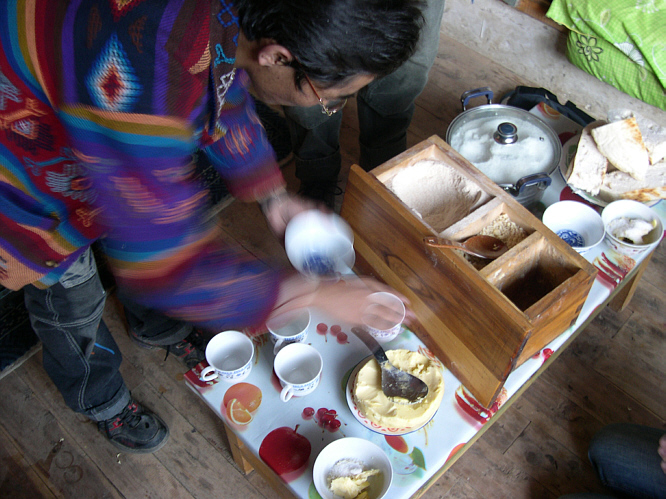
Abb.: Tsampa-Zubereitung, Tibet
[Bildquelle:
MexicoBrant. --
http://www.flickr.com/photos/accultured/289339256/. -- Zugriff am
2006-12-07. --


 Creative Commons Lizenz (namensnennung, keine Bearbeitung, keine
kommerzielle Nutzung)]
Creative Commons Lizenz (namensnennung, keine Bearbeitung, keine
kommerzielle Nutzung)]
| "Die Gerste (Hordeum vulgare,
engl. Barley, altdeutsch Bere) ist ein Getreide und gehört zur
Gattung Hordeum der Familie der Gräser (Poaceae).
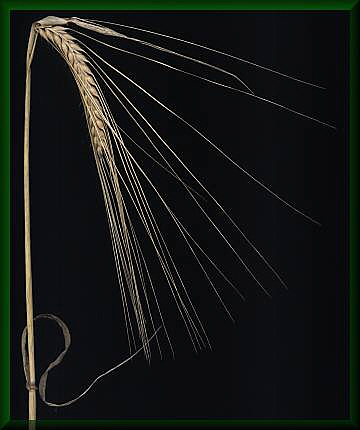
Abb.: Gerstenhalm
Merkmale
Die Pflanze wird 0,7 bis 1,2 m hoch. Der
Fruchtstand ist eine Ähre mit langen Grannen. Die Ähren sind im
reifen Zustand geneigt bis hängend. Morphologisches
Erkennungsmerkmal sind die langen, unbewimperten Blattöhrchen, die
den Halm vollständig umschließen. Das Blatthäutchen ist schmal und
leicht gezähnt. Botanisch betrachtet sind die Körner einsamige
Schließfrüchte (Karyopse). Gersten werden anhand ihrer
unterschiedlichen Ähren in zwei- und mehrzeilige Formen unterteilt.
Die zweizeiligen Formen entwickeln pro Ansatzstelle nur ein Korn,
das voll und kräftig ausgeprägt ist. Bei den mehrzeiligen Formen
treten drei Körner pro Ansatzstelle auf, die sich aber nicht so
kräftig entwickeln wie die der zweizeiligen Formen. 2-zeilige
Gerstensorten, meistens handelt es sich um Sommergerste, finden
vorwiegend Verwendung bei der Bierherstellung als Braugerste. 4- und
6-zeilige Gerstensorten, überwiegend Wintergerstensorten, werden als
Futtergerste angebaut.
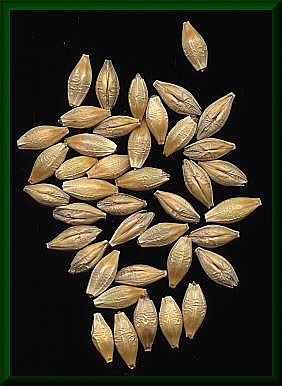
Abb.: Gerstenkörner
Herkunft
Ursprungsgebiete der Gerste sind der Vordere Orient und die östliche
Balkanregion. Die ältesten Nachweise der Gerste lassen sich bis
10500 v. Chr. zurückdatieren. Ab 7000 v. Chr. begann die
systematische Zuchtauswahl und seit der Jungsteinzeit (5000 v.
Chr.), findet auch in Mitteleuropa Gerstenanbau statt.
Während des Mittelalters war die Gerste als
ertragreiches Viehfutter geschätzt. Dank der Züchtung können die
Erträge, vor allem auf anspruchloseren Standorten, mit den
Weizenerträgen konkurrieren. Gerste ist eines der klassischen
Getreide der Antike. Sie ist vor mehr als 8000 Jahren im
Zweistromland und am Nil angebaut worden. Sie ist eng verwandt mit
der im Nahen
Osten vorkommenden Wildgerste (Hordeum vulgare subsp. spontaneum).
Anbau
Gerste gedeiht am besten auf tiefgründigen,
gut durchfeuchteten Böden. Aber auch mit ungünstigen Bedingungen
kommt sie gut zurecht und ersetzt dabei zum Beispiel in von Versalzung
betroffenen Gebieten andere Arten wie den Weizen. Ihre Winterhärte
ist weniger ausgeprägt als die von Weizen oder Roggen. Beim Anbau
wird zwischen Winter- und Sommergerste unterschieden. Die Aussaat
der Sommergerste erfolgt im Frühjahr. Sie reift in weniger als 100
Tagen heran und benötigt deutlich weniger Wärme als die
Wintergerste. Wintergerste ist ertragreicher und wird im September
gesät. Die Ausbildung von Nebentrieben (Bestockungstriebe) ist vor
dem Winter abgeschlossen. Aus ihnen entwickeln sich im Frühjahr die
Ähren tragenden Halme. Nach den Phasen der Bestockung, des Schossens
und des Ährenschiebens folgt die Blüte. Gerste zählt zu den
Selbstbefruchtern. In der Regel eröffnet die Wintergerste die
Getreideernte. Die Ernte erfolgt bei Gelb- bis Vollreife.
Wintergerste liefert, je nach Standort, zwischen 50-90 dt/ha,
Sommergerste zwischen 40-60 dt/ha Kornertrag. Unter der Bezeichnung
Bere läuft ein Typ von Gerste, der auf Orkney angebaut wird.
Nutzung
Da die Körner mit den Spelzen verwachsen
sind, besitzt die Gerste einen hohen
Zelluloseanteil (8–15 %). Ohne Spelzen enthalten Gerstenkörner 60–70 %
Kohlenhydrate, überwiegend in der Form von
Stärken, 11 % Proteine, 10 %
Ballaststoffe, je 2 % Fett und Mineralien sowie das Vitamin B. Gerste enthält Gluten,
was bei Personen mit Glutenunverträglichkeit zu gesundheitlichen
Problemen führen kann. Da Bier u. a. aus Gerste gebraut wird, wird
diesen Personen oftmals empfohlen, auch ihren Bierkonsum zu
reduzieren.
Die wirtschaftliche Bedeutung von Gerste ist
geringer als die der Getreidearten Weizen, Mais und Reis. Die
Kornerträge der Gerste werden überwiegend als Futtergetreide
verwendet, da insbesondere die Wintergerste relativ viel Eiweiß
(12–15 %) enthält. Für die menschliche Ernährung können aus Gerste Grütze
bzw. Graupen hergestellt werden; gelegentlich wird auch Mehl
erzeugt. Eine besondere Verwendungsform ist der Malzkaffee. Hierfür
muss die Gerste erst ankeimen, bevor sie als Malz gedarrt und dann
gemahlen wird. Ein erheblicher Anteil der zweizeiligen Sommergerste
dient der Biererzeugung, da deren Körner relativ wenig Eiweiß
(< 9 %) und viele Kohlenhydrate (> 65 %) enthalten. Der Gerste
werden auch Heilwirkungen zugesprochen (Gerstenwasser, auch als
Tisane bezeichnet, war im 19. Jahrhundert ein beliebtes Getränk für
Kranke). Schösslinge wirken entwässernd und fiebersenkend.
[...]
Produkte aus geschälten Gerstenkörnern
- Gerstengrütze
Hierfür werden die geschälten Gerstenkörner zu
Grütze geschnitten. Grütze wird in
unterschiedlicher Körnung in den Handel
gebracht.
- Graupen (auch:
Rollgerste oder Kochgerste) erhält man durch
Schleifen der Gerstenkörner, wobei auch die
Spitzen gerundet werden. Am bekanntesten sind
die "Perlgraupen". Dazu wird Grütze
auf Schleifmaschinen bearbeitet, bis sie ihre
rundliche Form erhalten.
- Gerstenflocken
werden aus hydrothermisch behandelten
Gerstenkörnern gewalzt.
- Gerstenmehl wird
durch die Vermahlung von Gerstenflocken
hergestellt. "
[Quelle:
http://de.wikipedia.org/wiki/Gerste. -- Zugriff am
2006-12-07] |
sa covāca tataḥ putrān
amībhiḥ saktubhiḥ sutā |
eko 'pi kṛcchrād varteta
bahūnāṃ tu kathaiva kā |123|
123. Da sprach er zu seinen Söhnen: "Meine Söhne, von
diesem geröstetes Gerstenmehl könnte kaum einer leben, was soll man da bei
vielen sagen?
tasmāt saṃbhakṣayatv ekaḥ
pratyahaṃ sajalān amūn |
yaḥ śakto yoganandasya
kartuṃ vairapratikriyām |124|
124. Darum soll Tag für Tag allein der dieses
Gerstenmehl samt dem Wasser aufessen, der fähig ist Yoga-Nandas Feindschaft zu
rächen."
tvam eva śakto bhuṅkṣvaitad
iti putrās tam abruvan |
prāṇebhyo 'pi hi dhīrāṇāṃ
priyā śatrupratikriyā |125|
Die Söhne erwiderten ihm: "Nur du bist dazu fähig. Iss
es du!" Standhaften ist ja Rache an ihren Feinden lieber als ihr Leben.
tataḥ sa śakaṭālas taiḥ
pratyahaṃ saktuvāribhiḥ |
eka evākarod vṛttiṃ
kaṣṭaṃ krūrā jigīṣavaḥ |126|
126. So erhielt sich Śakaṭāla mit dem täglichen
Gerstenmehl und Wasser ganz allein am Leben. Schlimm!, grausam sind Männer, die
siegen wollen.
abuddhvā cittam aprāpya
visrambhaṃ prabhaviṣṇuṣu |
na svecchaṃ vyavahartavyam
ātmano bhūtim icchatā |127|
127. "Jemand, der für sich Macht und Gedeih wünscht,
darf nie nach seinem Belieben handeln, ohne zuvor das Denken der Mächtigen
erkannt und ihr Vertrauen gewonnen zu haben."
iti cācintayat tatra
śakaṭālo 'ndhakūpagaḥ |
tanayānāṃ kṣudhārtānāṃ
paśyan prāṇodgamavyathām |128|
128. So sinnierte Śakaṭāla dort in der dunklen Grub
als er zusah, wie der Lebensodem seiner verhungernden Söhne dahinschwand.
tataḥ sutaśataṃ tasya
paśyatas tad vyapadyata |
tatkaraṅkair vṛto jīvann
atiṣṭhat sa ca kevalaḥ |129|
129. Dann traten seine hundert Söhne vor seinen Augen
ab. Allein er blieb inmitten ihrer Skelette am Leben.
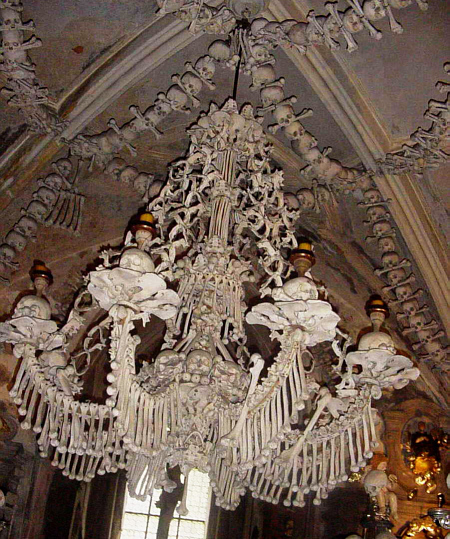
Abb.: Auch "inmitten ihrer Skelette": Kostnice Sedlec, Hřbitovní kostel Všech Svatých,
Sedlec, Kutná Hora (Kuttenberg), Tschechien
[Bildquelle: Wikipedia]
yoganandaś ca sāmrājye
baddhamūlo 'bhavat tataḥ |
vyāḍir abhyāyayau tam ca
gurave dattadakṣiṇaḥ |130|
130. Yoga-Nanda wurde dann in seiner Oberherrschaft
fest verwurzelt. Vyāḍi hatte dem Meister das Brahmanengeschenk übergeben und kam
zu ihm.
abhyetyaiva ca so 'vādīc
ciraṃ rājyaṃ sakhe 'stu te |
āmantrito 'si gacchāmi
tapas taptum ahaṃ kvacit |131|
131. Er trat vor ihn und sprach: "Freund!, deine
Herrschaft möge lange währen. Ich verabschiede mich. Ich gehe irgendwohin um
Askese zu treiben."
tac chrutvā yoganandas taṃ
bāṣpakaṇṭho 'py abhāṣata |
rājye me bhuṅkṣva bhogāṃs tvaṃ
muktvā māṃ mā sma gā iti |132|
132. Auf diese Worte antwortete Yoga-Nanda mit
tränenerstickter Stimme: "Genieße die Freuden in meinem Reich! Verlass mich
nicht und geh nicht fort!"
vyāḍis tato 'vadad rājañ
śarīre kṣaṇanaśvare |
evaṃprāyeṣv asāreṣu
dhīmān ko nāma majjati |133|
133. Vyāḍi antwortete: "König!, welcher Weise wird,
obwohl der Körper jeden Augenblick vergehen kann, in so vergängliche
Nichtigkeiten tauchen!
na hi mohayati prājñaṃ
lakṣmīr marumarīcikā |
ity uktvaiva sa tatkālaṃ
tapase niścito yayau |134|
134. Nicht blendet den Kundigen die Fata Morgana1
Glück und Reichtum2. Sofort nach diesen Worten ging er wg, zur
Askese fest entschlossen.
Kommentar:
1 Fata Morgana
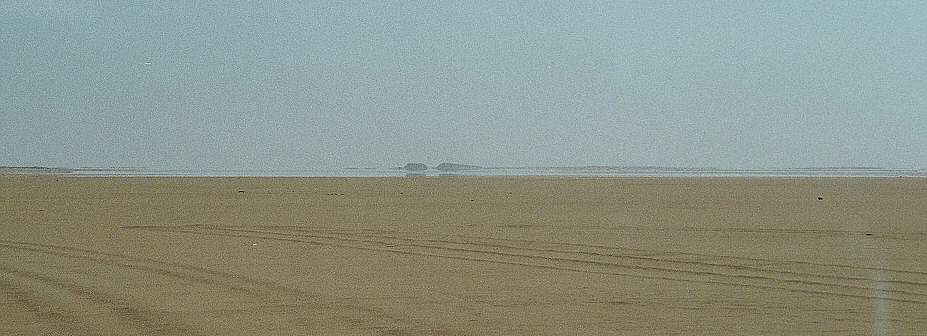
Abb.: Fata Morgana, Wüste, Ägypten
[Bildquelle:
JoSchmaltz. --
http://www.flickr.com/photos/joschmaltz/95779232/. -- Zugriff am
2006-12-07. --

 Creative
Commons Lizenz (Namensnennung)]
Creative
Commons Lizenz (Namensnennung)]
2 Glück und Reichtum: Lakṣmī: ist
auch die Gattin Viṣṇus!
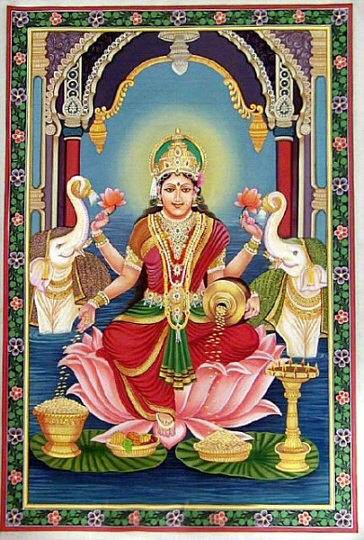
Abb.: Lakṣmī, die Göttin des Glücks der Schönheit und des Reichtums
[Bildquelle: Wikipedia]
agamad atha yoganandaḥ
pāṭaliputraṃ svarājanagaraṃ saḥ |
bhogāya kāṇabhūte
matsahitaḥ sakalasainyayutaḥ |135|
135. Kāṇabhūti!, dann zog Yoga-Nanda zusammen mit mir
und dem ganzen Heer nach Pāṭaliputra1, der Hauptstadt seines Reiches.
Kommentar:
Versmaß:
Āryā (eine Jāti, d.h, ein morenzählendes
Metrum)
yasyāḥ pāde prathame dvādaśamātrās tathā tṛtīye 'pi|
aṣṭādaśa dvitīye caturthake pañcadaśa sāryā ||
"Eine Āryā hat im ersten Pāda (Versviertel) zwölf
Moren (1 mātrā = 1 kurze Silbe), ebenso auch im dritten, im zweiten
achtzehn, im vierten fünfzehn."
In unserem Fall:
˘˘˘˘˘ˉ˘ˉˉ(12)
ˉ˘˘ˉˉ˘ˉ˘˘˘ˉˉ(18)
ˉˉ˘ˉ˘ˉˉ(12)
ˉ˘˘ˉ˘˘˘ˉ˘˘ˉ(15)
1 Pāṭaliputra: das heutige Patna (पटना).
Die Luftlinie Ayodhyā nach Pāṭaliputra beträgt 320 km. Man kann von Ayodhya
über den Ghaghara-Fluss (Ghogra), einen Zufluss des Ganges, und den Ganges
auf dem Wasserweg nach Pāṭaliputra kommen.
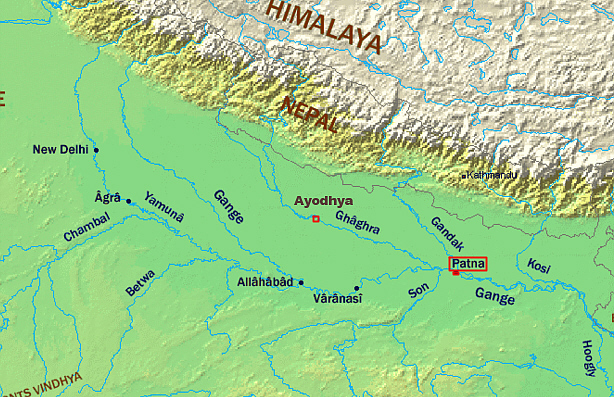
Abb.: Ayodhyā - Pāṭaliputra
[Bildquelle: Wikipedia]
tatropakośāparicaryamāṇaḥ
samudvahan mantridhurāṃ ca tasya |
ahaṃ jananyā gurubhiś ca sākam
āsādya lakṣmīm avasaṃ cirāya |136|
136. Dort weilte ich lange zusammen mit meiner Mutter
und meinen Meistern, wurde von Upakośā umhegt, führte die Aufgabe seines
Ministers aus und traf auf Glück und Reichtum1.
Kommentar:
Versmaß:
Upajāti:
syād indravajrā yadi tau jagau gaḥ |
upendravajrā prathame laghau sā |
anantarodīritalakṣmabhājau
pādau yadīyāv upajātayas tāḥ |
"Eine Indravajrā ist es, wenn ta ta ja ga ga
vorliegt.
Eine Upendravajrā ist eine Indravajrā, bei der die erste Silbe kurz ist.
Wenn zwei Viertelverse Eigenschaften der beiden eben genannten Versmaße
haben, dann handelt es sich um Upajātis."
In unserem Fall:
ta ta ja ga ga (a,d) (11) (Indravajrā)
ja ta ja ga ga (b,c) (11) (Upendravajrā)
ˉˉ˘ˉˉ˘˘ˉ˘ˉˉ
˘ˉ˘ˉˉ˘˘ˉ˘ˉˉ
˘ˉ˘ˉˉ˘˘ˉ˘ˉˉ
ˉˉ˘ˉˉ˘˘ˉ˘ˉˉ
1 Glück und Reichtum: Lakṣmī: ist
auch die Gattin Viṣṇus
bahu tatra dine dine dyusindhuḥ
kanakaṃ mahyam adāt tapaḥprasannā |
vadati sma śarīriṇī ca sākṣān
mama kāryāṇi sarasvatī sadaiva |137|
137. Meiner Askese wohlgesonnen, schenkte mir
der Himmelsfluss1 täglich Gold2. Sarasvatī3,
sichtbar in leiblicher Gestalt, sagte mir stets, was ich zu tun hatte.
Kommentar:
Versmaß:
Ein Ardhasamavṛtta
sa sa ja ga ga (a,c) (11)
sa bha ra ya (b,d) (12)
˘˘ˉ˘˘ˉ˘ˉ˘ˉˉ
˘˘ˉˉ˘˘ˉ˘ˉ˘ˉˉ
˘˘ˉ˘˘ˉ˘ˉ˘ˉˉ
˘˘ˉˉ˘˘ˉ˘ˉ˘ˉˉ
1 Himmelsfluss: dyusindhu: Ganges
2 Gold: es handelt sich um sog. Goldseifen, d.h.
Anschwemmungen von Gold, unter Umständen größeren Klumpen (Nuggets) durch
den Ganges. Heute ist die Ausbeute an alluvialem Gold in Indien gering.
Nuggets werden kaum gefunden [siehe: The Wealth of India : a
dictionary of Indian raw materials and industrial products. -- New Delhi :
Council of Scientific and Industrial Research. -- Vol. IV: F - G. -- 1956.
-- S. 163]
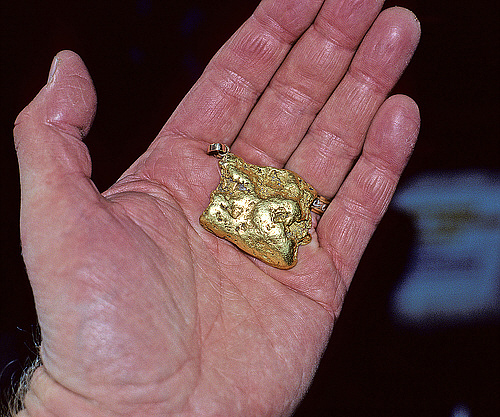
Abb.: Gold-Nugget, allerdings nicht aus dem Ganges, sondern aus dem Klondike
River, Dawson City, Kanada
[Quelle:
JDB99. --
http://www.flickr.com/photos/jdb99/158477064/. -- Zugriff am 2006-12-07.
--

 Creative
Commons Lizenz (Namensnennung)]
Creative
Commons Lizenz (Namensnennung)]
| "Unter Seifen versteht man in der Geologie
und in der
Lagerstättenkunde sekundäre Mineralanreicherungen in Sedimenten, wie Sand und Kies.
Handelt es sich hierbei um
abbauwürdige Konzentrationen von
Edelmetallen,
Schwermineralen oder Edelsteinen, so spricht man von Seifenlagerstätten.
Wegen ihrer Verwitterungsbeständigkeit und ihres
hohen Gewichts werden diese Minerale von Wind und Wasser
angereichert. Hierbei unterscheidet man herkömmlicher Weise:
[...]
- Alluviale oder Flussseifen in
fließenden Gewässern gehörten in der Vergangenheit zu den
wichtigsten Seifenlagerstätten. Aber auch heute noch stammt ein
Großteil der weltweiten Zinn-Produktion aus den Seifen in
Brasilien und Malaysia. Trotz der jahrtausendlangen Erfahrung
der Menschheit mit solchen Seifen, sind die genauen Prozesse der
Anreicherung auch heute noch nicht völlig verstanden. Es handelt
sich hierbei um ein komplexes Zusammenspiel von
Strömungsgeschwindigkeit, Sinkgeschwindigkeit, Auftreten von
Turbulenzen,
spezifischem Gewicht und der
hydraulischen Äquivalenz der Mineralkörner. Die bedeutendsten Seifen bilden sich
während der Verlagerung von mäandrierenden Flussarmen (die als
"tote Arme" später recht weit vom Fluss entfernt liegen
können!).
[...]
Größere Gold- oder Platinklumpen heißen Nuggets.
Die Goldvorkommen am Fluss
Klondike in Yukon, Kanada sind der Stoff für Geschichten und Filme. Auch an Rhein, Donau, Isar
und Eder wurden bis vor 100 Jahren Goldseifen ausgebeutet. In
jüngster Zeit werden wieder Versuche gemacht, Gold aus Kies von
Baggerseen zu gewinnen, da bei den industriellen Sieb- und
Waschvorgängen die Gold-Konzentration bereits um das Fünffache
zunimmt. Eine Pilotanlage steht in
Balaguer in Spanien und erste Versuche waren erfolgversprechend.
Die größte bekannte Goldseife liegt im
Witwatersrand bei
Johannesburg in Südafrika – einem archäischen verfestigten uranhaltigen Quarz-Konglomerat
mit einer Matrix aus Pyrit,
Sericit und Quarz."
|
3 Sarasvatī
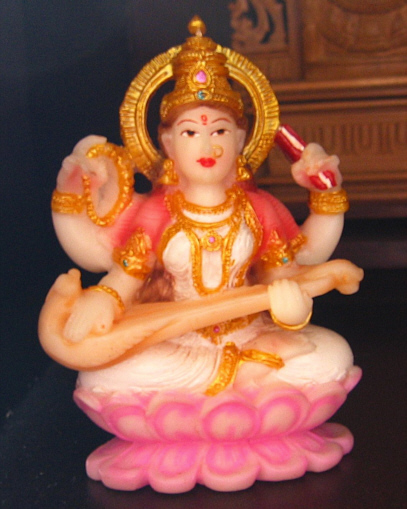
Abb.: Sarasvatī
[Bildquelle. Wikipedia]
| "Saraswati (Sanskrit, f., सरस्वती,
Sarasvatī) ist eine indische Göttin, die
die weibliche Kraft (Shakti) des Gottes Brahma ist. Sie ist die
älteste Göttin des Hinduismus und wird schon im Rig Veda erwähnt.
Ursprünglich war sie eine Flussgöttin und wird auch heute noch mit
dem fruchtbaren und reinen Wasser und dem
Soma in Verbindung gebracht. Sie gilt als Göttin der Weisheit, des Intellekts,
der Musik, Gelehrsamkeit, Sprache und Poesie, die die Schrift
erfunden hat. Sie gilt als Verkörperung und Beschützerin der Kultur
und der Künste. Sie wird als schlanke,
junge Frau gezeigt, die vier Arme hat, in denen sie ein Gefäß mit
Wasser trägt, ein Saiteninstrument (die Vina), eine Mala
(Rosenkranz) und die Veden. Sie gilt als Verkörperung der Reinheit
und
Transzendenz. So ist ihr Reittier auch der Schwan, im Hinduismus ein Symbol der
spirituellen Transzendenz und Perfektion. Oft wird sie auch auf einem Lotos
sitzend dargestellt.
In der hinduistischen Mythologie wird
erzählt, Saraswati sei aus dem Gott Brahma geboren worden. Brahma
hatte das Verlangen, die Schöpfung hervorzubringen und begab sich in Meditation,
woraufhin sich sein Körper in eine männliche und eine weibliche
Hälfte, Saraswati, teilte. Brahma vereinte sich mit ihr und daraus
entstand der Halbgott Manu, der die Welt erschuf. Oft wird auch
erzählt, Saraswati entstamme dem Mund des Brahma und sei entstanden
als dieser die Welt durch seine schöpferische Rede erschuf.
In einem anderen Mythos ist es Krishna, aus
dem Saraswati entsteht. Dieser teilte sich in männlich und weiblich,
Geist und Materie (Purusha und Prakriti) um die Welt zu erschaffen.
Die weibliche Hälfte nahm die Form von fünf dynamischen Kräften oder
Shaktis an, von denen eine Saraswati war. Ihre Funktion war es die
Wirklichkeit mit Innenschau, Wissen und Lernen zu verbinden.
Vasant Panchami, der wichtigste
Feiertag der Göttin, auch Saraswati Puja genannt, findet im
Frühjahr statt. Bilder der Göttin werden in Schulen und
Universitäten aufgestellt, Bücher, Schreibzeug, Musikinstrumente und Gurus
werden geehrt und es gibt kulturelle Programme und Prozessionen.
In vielen indischen Religionen wird Saraswati
verehrt, nicht nur im Hinduismus, sondern auch im Jainismus und Buddhismus.
In Japan ist sie unter dem Namen Benten oder Benzaiten bekannt. In
Südindien beginnen Konzerte mit traditioneller Musik mit einer Invokation
der Göttin.
Literatur
- David Kinsley: Hindu Goddesses.
University of California Press 1986
ISBN 0-520-05393-1"
[Quelle:
http://de.wikipedia.org/wiki/Saraswati. -- Zugriff am
2006-12-08] |
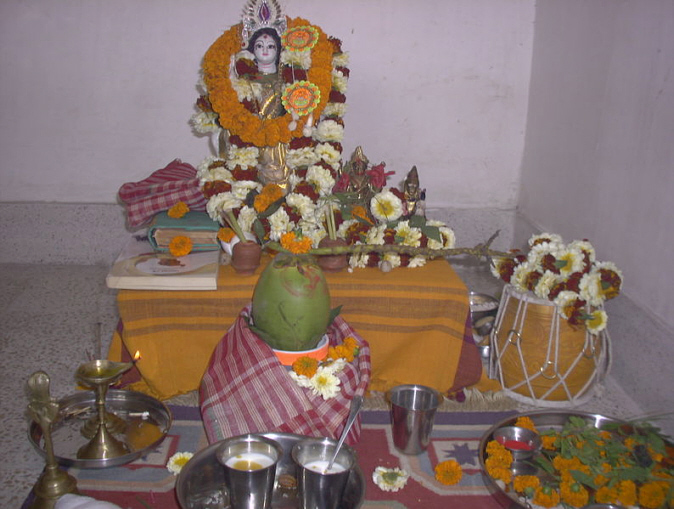
Abb.: Altar für Sarasvatī-Pūjā
[Bildquelle. Wikipedia]
iti mahākaviśrīsomadevabhaṭṭaviracite kathāsaritsāgare
kathāpīṭhalambake caturthas taraṅgaḥ
Zu: 6. Buch I, Welle 5.














